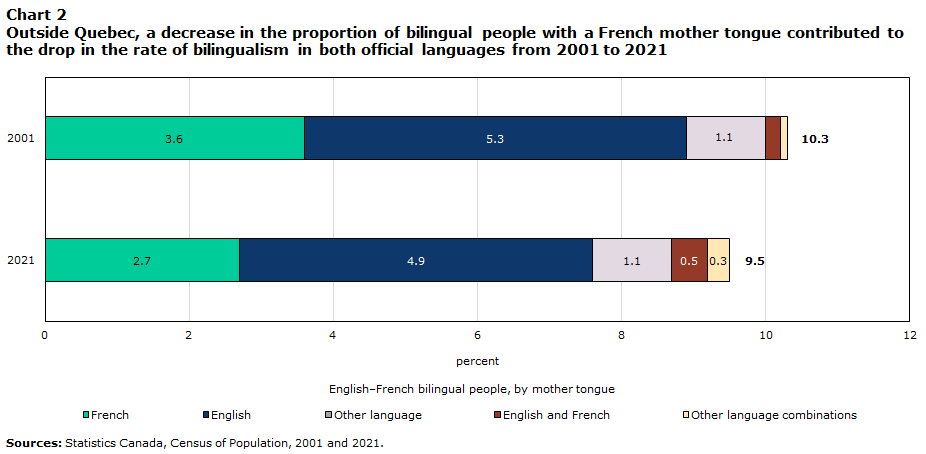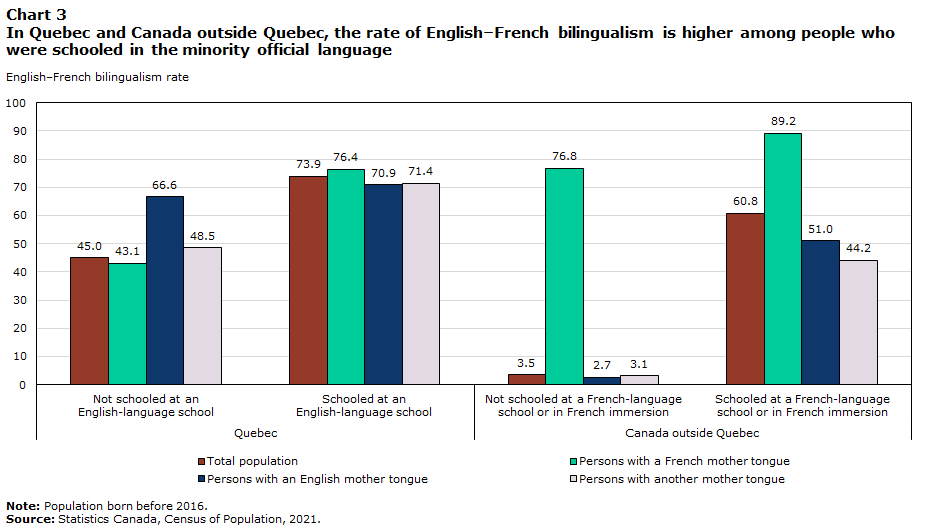Recent trends after five decades of official bilingualism

Start of text box 1
Highlights
-
In 2021, nearly one in five people (18.0%) in
Canada could have a conversation in English and French, representing close to 6.6 million
people. While this proportion has never been this high in a census, it has
remained stable compared with 2001 (17.7%). -
In Quebec, the rate of English–French
bilingualism rose from 40.8% in 2001 to 46.4% in 2021, while over the same
period, it fell from 10.3% to 9.5% in Canada outside Quebec overall. However, the
rate of bilingualism in both official languages was increasing in Newfoundland
and Labrador, Prince Edward Island, Yukon and the Northwest Territories. -
The increase in the rate of bilingualism in both
official languages in Quebec was driven by two key factors. One factor is the
rise in the English–French bilingualism rate of the population with a French
mother tongue from 36.6% in 2001 to 42.2% in 2021. The other factor is an
increase in the demographic weight of the population with another mother
tongue, i.e., a language other than English or French, with just over half of
this population (50.8% in 2021) being able to have a conversation in Canada’s
two official languages. -
Two key drivers are also behind the decrease in
the rate of English–French bilingualism observed since 2001 in Canada outside Quebec. The first is the
decline in the demographic weight of the French-mother-tongue population, of
which a high proportion is proficient enough in both official languages to
conduct a conversation (85.3% in 2021). The second is the decline in the English–French
bilingualism rate of the population with another mother tongue, which fell from
5.7% in 2001 to 4.7% in 2021. -
In Canada outside Quebec, approximately three in
five people (60.8%) who attended a French-language school or a French immersion
program could have a conversation in both official languages, compared with 3.5%
of those who did not attend these schools or immersion programs.
End of text box 1
Introduction
The Official Languages Act was adopted
in 1969, making English and French Canada’s official languages. Official bilingualism
is both symbolic and tangible. On one hand, it reflects the importance of
English and French in Canada’s history and identity, and in the everyday life
of communities across the country. On the other, having an officially bilingual
federal government is a guarantee to those living in Canada that the government
will provide its services in English and in French, where demand warrants. This
is why greater English–French bilingualism is of particular interest in Canada:
it fosters mutual understanding and communication between English- and
French-speaking communities and it ensures that the right of people living in
Canada to receive federal services in either official language is respected.
With each census, the number of people who are
able to have a conversation in English and French has continued to grow in
Canada, totalling almost 6.6 million people in 2021. From the early 1960s to
the turn of the century, the rate of English–French bilingualism in Canada rose
sharply from 12.2% in 1961 to 17.7% in 2001. Since then, the proportion of the
Canadian population who is bilingual in English and French has been relatively
stable, with the bilingualism rate reaching 18.0% in 2021. Nonetheless, this is
the highest proportion ever observed in a census.
The stability in the bilingualism rate
observed recently is the result of two diverging trends: the increase in the
rate of English–French bilingualism in Quebec, which offset the decrease
observed outside the province.
Today, Statistics Canada is publishing an
analysis of the evolution of English–French bilingualism in Canada, which also
examines how changes in the demographic weight and bilingualism rate of
populations with an English, French or other mother tongue have contributed to
this evolution. Lastly, this report provides a glimpse into the link between
schooling in the minority official language and English–French bilingualism.
Start of text box 1
Parlez-vous français? Do you speak English?
English–French bilingualism, or bilingualism in both official languages, refers to the ability to have a conversation in English and French, Canada’s two official languages. In the census question on knowledge of official languages, people report their ability to have a conversation in English, French, English and French, or neither.
The very first questions on the ability to speak English and French appeared in the 1901 Census of Population. At the time, 14.7% of Canada’s population knew English and French.
End of text box 1
The rate of English–French bilingualism increases in Quebec and falls in Canada outside Quebec
In Canada and in each province and
territory, except Alberta and Nunavut, there were a record number of bilingual
English–French people in 2021.
However, since the 2001 Census, the growth
of the population who speaks English and French well enough to conduct a
conversation has been lower or similar to the growth of the rest of the population
in many provinces and territories, resulting in a declining or stable English–French
bilingualism rate in these provinces and territories. For example, in New Brunswick,
Canada’s only officially bilingual province, the English–French bilingualism rate
has been stable,Note 1
standing at 34.2% in 2001 and 34.0% in 2021. In contrast, the bilingualism rate
was higher in Newfoundland and Labrador, Prince Edward Island, Quebec, Yukon,
and the Northwest Territories in 2021 than 20 years earlier.
In Canada outside Quebec as a whole, the
rate of English–French bilingualism was on an upward trend from 1961 (6.9%) to
the turn of the century (10.3% in 2001). Since then, with the exception of a
slight rebound between 2011 and 2016, this rate fell from one cycle to the
next, totalling 9.5% in 2021.
In Quebec, aside from a small decline from 2001
to 2006, the English–French bilingualism rate has been rising with each census
since the early 1960s, increasing from 25.5% in 1961 to 40.8% in 2001, then
reaching 46.4% in 2021. In other words, almost one in two people in Quebec could
have a conversation in Canada’s two official languages in 2021.
Data table for map 1
| Rate of bilingualism in both official languages | |||
|---|---|---|---|
| 2001 | 2021 | Change from 2001 to 2021 | |
| Canada | 17.7 | 18.0 | Stable |
| Canada outside Quebec | 10.3 | 9.5 | Decrease |
| Newfoundland and Labrador | 4.1 | 5.1 | Increase |
| Prince Edward Island | 12.0 | 12.7 | Increase |
| Nova Scotia | 10.1 | 10.3 | Stable |
| New Brunswick | 34.2 | 34.0 | Stable |
| Quebec | 40.8 | 46.4 | Increase |
| Ontario | 11.7 | 10.8 | Decrease |
| Manitoba | 9.3 | 8.3 | Decrease |
| Saskatchewan | 5.1 | 4.7 | Stable |
| Alberta | 6.9 | 6.1 | Decrease |
| British Columbia | 7.0 | 6.6 | Stable |
| Yukon | 10.2 | 14.2 | Increase |
| Northwest Territories | 8.4 | 10.6 | Increase |
| Nunavut | 3.8 | 3.8 | Stable |
The increase in English–French
bilingualism in Quebec and the decrease observed in Canada outside Quebec since
the turn of the century can be observed in the geographic distribution of
Canadians who can have a conversation in both official languages. In Canada,
the proportion of English–French bilingual people living in Quebec increased
from 55.6% in 2001 to 59.2% in 2021, bringing it closer to the level observed
in 1961 (60.0%).
Moreover, the rate of bilingualism in both
official languages was higher in regions where English- and French-language
communities are in close contact, either in the same territory or in adjacent
territories. These regions are, in fact, among those with the highest rates of English–French
bilingualism in the country. For example, in 2021, Canada’s census metropolitan
areas (CMA) with the highest bilingualism rates were GatineauNote 2 (64.6%), Montréal (56.4%),
Sherbrooke (46.0%) and Moncton (45.9%).
| Census metropolitan area (CMA) | English–French bilingualism rate | ||
|---|---|---|---|
| 2001 | 2021 | Variation from 2001 to 2021 | |
| percent | percentage points | ||
| Quebec (province) | 40.8 | 46.4 | 5.6 |
| Gatineau | 64.0 | 64.6 | 0.6 |
| Montréal | 52.4 | 56.4 | 4.0 |
| Sherbrooke | 41.1 | 46.0 | 4.9 |
| Québec (CMA) | 32.6 | 41.5 | 8.9 |
| Trois-Rivières | 26.0 | 32.4 | 6.4 |
| Drummondville | 23.7 | 30.0 | 6.3 |
| Saguenay | 18.4 | 23.7 | 5.3 |
| Non-CMAs | 24.6 | 30.4 | 5.8 |
| Canada outside Quebec | 10.3 | 9.5 | -0.8 |
| Moncton | 47.0 | 45.9 | -1.1 |
| Greater Sudbury | 40.4 | 36.7 | -3.7 |
| Ottawa | 36.2 | 36.4 | 0.2 |
| Fredericton | 20.6 | 22.5 | 1.9 |
| Other CMAs | 8.1 | 7.3 | -0.8 |
| Non-CMAs | 10.4 | 9.5 | -0.9 |
From 2001 to 2021, the English–French
bilingualism rate increased in all large urban centres in Quebec. This rate
rose 5.6 percentage points in the province during this period, but the
increase was even larger in the CMAs of Québec (+8.9 percentage points), Trois-Rivières
(+6.4 percentage points) and Drummondville (+6.3 percentage points), and
in regions outside CMAs (+5.8 percentage points). In contrast, the growth
of the bilingualism rate was smaller in the CMAs of Gatineau (+0.6 percentage
points) and Montréal (+4.0 percentage points)—two CMAs that, in 2001, already
had the highest bilingualism rates in the country.
The rate of English–French bilingualism declined
0.8 percentage points from 2001 to 2021 in Canada outside Quebec, as well
as in Greater Sudbury (-3.7 percentage points) and Moncton (-1.1 percentage
points), but remained stable (+0.2 percentage points) in Ottawa.Note 3 In contrast, the
bilingualism rate increased in Fredericton (+1.9 percentage points), New
Brunswick’s capital, during the same period.
Lastly, the English–French bilingualism rate
was even higher in certain municipalitiesNote 4
in regions with large proportions of people in a minority language situation. For
example, in 2021, more than four in five people were English–French bilingual
in Fort-Coulonge (82.0%) in Quebec’s Outaouais region, and in Bouctouche (81.2%)
in southeastern New Brunswick.
In Quebec, French speakers learning
English and immigration drive the English–French bilingualism
rate upward
Across Canada, the prevalence of English–French
bilingualism varies according to the first language learned in childhood, i.e.,
mother tongue.Note 5
In Quebec, the rate of English–French
bilingualism was 46.4% in 2021. For many decades, the bilingualism rate of
Quebeckers with an English mother tongue has been higher than the rate for the provincial
population, totalling 67.1% in 2021. Because this English-speaking population
is a minority in the province, it is more likely to come into contact with the
other official language community and learn its language.
Similarly, the English–French bilingualism rate
was higher than the average among Quebeckers with another mother tongue, with
just over half being able to have a conversation in Canada’s two official
languages in 2021 (50.8%). Among people with another mother tongue—more than
three-quarters (76.4%) of whom are immigrants or non-permanent residents—English
and French are at least the second or third languages they learned.
Lastly, the rate of bilingualism in both
official languages of Quebeckers with a French mother tongue was lower than the
average provincial rate in 2021. However, the bilingualism rate of this group grew
the most from 2001 to 2021, increasing 5.6 percentage points from 36.6% to
42.2%. Growth in the bilingualism rate was slower in the populations with an
English mother tongue (+1.0 percentage point) or another mother tongue (+0.4 percentage
points).
From 2001 to 2021, the English–French bilingualism
rate of the French-mother-tongue population in Quebec rose among both younger
people and core-aged adults in the labour market. Over this period, this rate increased
more than 12 percentage points for each five-year age group from 10 to 44 years.
In addition, the bilingualism rate of the population with a French mother
tongue rose in all the province’s regionsNote 6
and large urban centres.
The demographic weight of Quebec’s
French-mother-tongue population decreased from 80.9% in 2001 to 74.8% in 2021. By
comparison, the demographic weight of the population with an English mother
tongue was more stable, edging down from 7.8% to 7.6%, while the weight of the population
with another mother tongue advanced from 10.0% to 14.0%, driven by immigration.
The combined effect of the changes in the demographic weights and the
prevalence of bilingualism based on mother tongue accounts for the increase in
the English–French bilingualism rate in Quebec from 2001 to 2021.

Data table for chart 1
| English–French bilingual people, by mother tongue | ||
|---|---|---|
| 2001 | 2021 | |
| percent | ||
| French | 29.6 | 31.6 |
| English | 5.2 | 5.1 |
| Other language | 5.0 | 7.1 |
| English and French | 0.7 | 1.4 |
| Other language combinations | 0.4 | 1.2 |
| Total | 40.8 | 46.4 |
The proportion of Quebeckers who could
conduct a conversation in Canada’s two official languages increased 5.6 percentage
points from 2001 to 2021. A large share of this gain is attributable to the growth
in the proportion of the population who is bilingual in English and French and
has a French mother tongue (+2.0 percentage points) or another mother
tongue (+2.1 percentage points). On one hand, the increase in the bilingualism
rate of the French-mother-tongue population more than offset the decrease in
its demographic weight. On the other, the bilingualism rate of the population
with another mother tongue was stable from 2001 to 2021, but its demographic
weight increased thanks to immigration.
The increase in the English–French
bilingualism rate in Quebec from 2001 to 2021 was also driven by the growth of
the bilingual population with more than one mother tongue, i.e., individuals
who learned English and French (+0.7 percentage points) or another
language combination (+0.8 percentage points) at the same time in
childhood. For more information on individuals with more than one mother tongue,
see the box entitled “Bilingual from childhood.”
Fewer French speakers and more Asian-born
speakers of another language contribute to the decline in the rate of
bilingualism in both official languages in Canada outside Quebec
Like in Quebec, a large proportion of the population
in Canada outside Quebec whose first language is the minority official
language—French, in this case—could carry on a conversation in both official
languages in 2021 (85.3%). By comparison, the English–French bilingualism rates
of individuals with an English or another mother tongue were lower; around 1 in
14 English speakers (7.1%) and fewer than 1 in 20 speakers of another language
(4.7%) were proficient enough in both official languages to conduct a conversation.
In Canada outside Quebec, the English–French
bilingualism rate of the population with another mother tongue fell 1
percentage point from 5.7% in 2001 to 4.7% in 2021. In comparison, this rate
was more stable among French speakers (+0.2 percentage points) and English
speakers (no change).
The English–French bilingualism rate of the
population with an English mother tongue remained stable over this period due
to diverging trends between certain age groups. One of these trends is the
rising bilingualism rate of young English speakers aged 5 to 14, which increased
from 8.8% in 2001 to 11.2% in 2021. One factor that drove this rate upward was
the growing number of young people in French immersion programs. In contrast, the
bilingualism rate of English speakers aged 20 to 29 decreased from 12.0% in 2001
to 9.0% in 2021.
The 1 percentage-point decrease in the
bilingualism rate of the other-mother-tongue population is due in part to a
change in the composition of this population by place of birth. From 2001 to
2021, the proportion of people with another mother tongue who were born in an
Asian country rose sharply on account of immigration (from 35.6% to 55.2%), while
the proportion of this population born in Europe dropped from 27.9% to 15.8%. In
2021, the English–French bilingualism rate was lower among individuals with
another mother tongue born in Asia (2.0%) than among their counterparts born in
Europe (6.0%), in the Americas (excluding Canada) (8.1%) or in Africa (13.8%). The
growing proportion of Asian-born non-official language speakers and the decline
in the proportion of non-official language speakers born in Europe therefore
contributed to the drop in the bilingualism rate of non-official language
speakers in Canada outside Quebec.
Start of text box 1
Multilingual despite a lower rate of bilingualism in both official languages
In Canada outside Quebec in 2021, more than one in eight people were Asian-born and had another mother tongue. Of these people, 2.0% could have a conversation in English and French. Although their rate of bilingualism in both official languages is lower, these individuals were multilingual. In fact, one-quarter (25.0%) could have a conversation in at least three languages, be it an official or another language. Most often, these individuals knew English and at least two other non-official languages. The ability to have a conversation in French was rarer.
In addition, of Asian-born individuals with another mother tongue who were living in Canada outside Quebec in 2021, the English–French bilingualism rate was higher among those who had immigrated during their childhood (5.2%), since they were able to start or continue their schooling in Canada. The bilingualism rate was also higher among people born in certain Asian countries, such as Lebanon (23.6%) and Iran (4.7%), while it was lower among people born in the Philippines (0.6%) and India (0.9%).
End of text box 1
From 2001 to 2021, the demographic weight
of the population with a French mother tongue in Canada outside Quebec decreased
(from 4.2% to 3.2%), as did the weight of the English-mother-tongue population
(from 74.6% to 69.0%). In contrast, the demographic weight of individuals with
another mother tongue rose from 20.0% to 24.0%. The combined effect of the
change in the demographic weights of these populations and their knowledge of
official languages accounts for the decrease in the English–French bilingualism
rate in Canada outside Quebec over this period.

Data table for chart 2
| English–French bilingual people, by mother tongue | ||
|---|---|---|
| 2001 | 2021 | |
| percent | ||
| French | 3.6 | 2.7 |
| English | 5.3 | 4.9 |
| Other language | 1.1 | 1.1 |
| English and French | 0.2 | 0.5 |
| Other language combinations | 0.1 | 0.3 |
| Total | 10.3 | 9.5 |
In both 2001 and 2021, English was the
mother tongue of more than half of bilingual English–French people in Canada outside
Quebec.
In 2021, 9.5% of people in Canada outside
Quebec could have a conversation in English
and French, a decrease of 0.8 percentage points from 2001. Much of this decrease
stems from the decline in the proportion of the bilingual population whose mother
tongue is French (-0.9 percentage points). The proportion of bilingual people with
an English mother tongue also fell during this period (-0.4 percentage
points). However, this downturn was offset by the growth of the bilingual population
whose first languages learned in childhood were English and French (+0.3
percentage points) and of the bilingual population with another combination of
mother tongues (+0.2 percentage points).
Lastly, although people whose mother tongue
is a non-official language make up a growing proportion of the Canadian population
outside Quebec, the decline in their rate of bilingualism in both official
languages held the proportion of bilingual people with another mother tongue in
Canada outside Quebec stable at 1.1% in 2001 and 2021.
Start of text box 1
Bilingual from childhood
Since the turn of the century, a growing proportion of Canadians have
reported having learned two or more languages at the same time in childhood, be
it a combination of English, French or another language. In 2001, this
proportion was 1.3% and rose to 3.8%Note 7 in 2021. More in-depth analysis is required to better understand this
increase. Among the many factors that may have contributed to this gain is
the increasing number of children who grow up in families where more than one
language is spoken at home, such as in exogamousNote 8 or immigrant families.
The English–French bilingualism rate of people with more than one
mother tongue attests to the fact that they first learned more than one
language in childhood. For example, in Quebec in 2021, the bilingualism rate of
those with English and French as their mother tongues was 93.3%, while the
rate for those with another mother tongue combination stood at 58.6%. The
corresponding proportions in Canada outside Quebec were 83.3% and 9.3%, respectively.
However, not everyone whose mother tongues are English and French
were able to have a conversation in both official languages at the time of
the census. Sometimes, people who do not fluently speak one of the first
languages they learned feel they can no longer have a conversation in that
language, even though they can still understand it. This is especially true
as people get older. For example, in Quebec, the rate of bilingualism in both
official languages of people with English and French as their mother tongues
was 96.7% among speakers aged 10 to 29, compared with 82.1% among those aged 75 and
older.
End of text box 1
The English–French bilingualism rate
peaks among individuals who attended primary or secondary school in the
minority official language
The ability to have a conversation in a
second language varies by a person’s age and educational pathway.Note 9 For example, in 2021, the
English–French bilingualism rate was higher among Quebec residents who attended
an English school and residents of Canada outside Quebec who attended a French
school or a French immersion program for all or part of their primary or
secondary education than among individuals who did not attend these schools or
programs.
In Quebec, close to
three-quarters of people who attended an English-language schoolNote 10 (73.9%) reported being
able to have a conversation in Canada’s two official languages in 2021, compared
with 45.0% of people who did not attend an English-language school, a gap of 28.9 percentage
points. The difference in the bilingualism rate of people schooled in English
and those who were not was greater among individuals with a French mother
tongue (33.3 percentage points) or another mother tongue (22.9 percentage points), and smaller
among people with an English mother tongue (4.3 percentage points).

Data table for chart 3
| Total population | Persons with a French mother tongue | Persons with an English mother tongue | Persons with another mother tongue | |
|---|---|---|---|---|
| English–French bilingualism rate | ||||
| Quebec | ||||
| Not schooled at an
English-language school | 45.0 | 43.1 | 66.6 | 48.5 |
| Schooled at an
English-language school | 73.9 | 76.4 | 70.9 | 71.4 |
| Canada outside Quebec | ||||
| Not schooled at a French-language school or in French immersion | 3.5 | 76.8 | 2.7 | 3.1 |
| Schooled at a
French-language school or in French immersion | 60.8 | 89.2 | 51.0 | 44.2 |
Similarly, in Canada outside Quebec, the English–French
bilingualism rate in 2021 was higher among individuals schooled in FrenchNote 11 (60.8%) than
among those who were not (3.5%). The difference was especially large among
those with an English mother tongue (48.3 percentage points) or another
mother tongue (41.1 percentage points), while it was smaller among those
with a French mother tongue (12.4 percentage points).
Lastly, there are a number of reasons why a
person schooled in the minority official language may report not being able to
conduct a conversation in both official languages. For example, some people may
have only done part of their schooling (e.g., one year) in the minority
official language. Or it may have been years since they finished primary or
secondary school, and during those years, they have not spoken the minority
official language enough to continue being able to have a conversation. Likewise,
some people may, over time, report no longer being able to have a conversation
in the first language they learned. Further studies are needed to get a better
understanding of the different life pathways associated with the loss or
maintenance over time of the ability to have a conversation in a language.
Looking ahead
This article gives an overview of recent
trends associated with the evolution of the English–French bilingualism rate in
Quebec, in Canada outside Quebec and in Canada. The results of the 2021 Census
and previous censuses provide insight into how the change in the demographic
weight of groups of speakers as well as their bilingualism rate led to a record
proportion of Canadians who were able to have a conversation in both official
languages in 2021.
For the first time, the 2021 Census results
shed light on the importance of the language of schooling at the primary and
secondary levels to learn the official languages. Future studies on topics such
as participation in French immersion programs in Canada outside Quebec will give
a clearer picture of this situation.
Additional information
The key 2021 Census results on knowledge of English and French in Canada were published on August 17, 2022, in the Daily article “While English and French are still the main languages spoken in Canada, the country’s linguistic diversity continues to grow” and in the infographic “More than one language in the bag: The rate of English–French bilingualism is increasing in Quebec and decreasing outside Quebec.”
Additional information on knowledge of official languages can be found in data tables and the Census Profile.
Reference products are designed to help users make the most of 2021 Census data. These include the Guide to the Census of Population, 2021, the Dictionary, Census of Population, 2021 and the 2021 Census of Population questionnaires. The Languages Reference Guide is also available.
Acknowledgements
This report was prepared by Étienne Lemyre of Statistics Canada’s Centre for Demography, with the assistance of other staff members of this Centre and the collaboration of staff from the Census Subject Matter Secretariat, the Census Operations Division, the Communications Branch, and the Data Access and Dissemination Branch.
Source link



